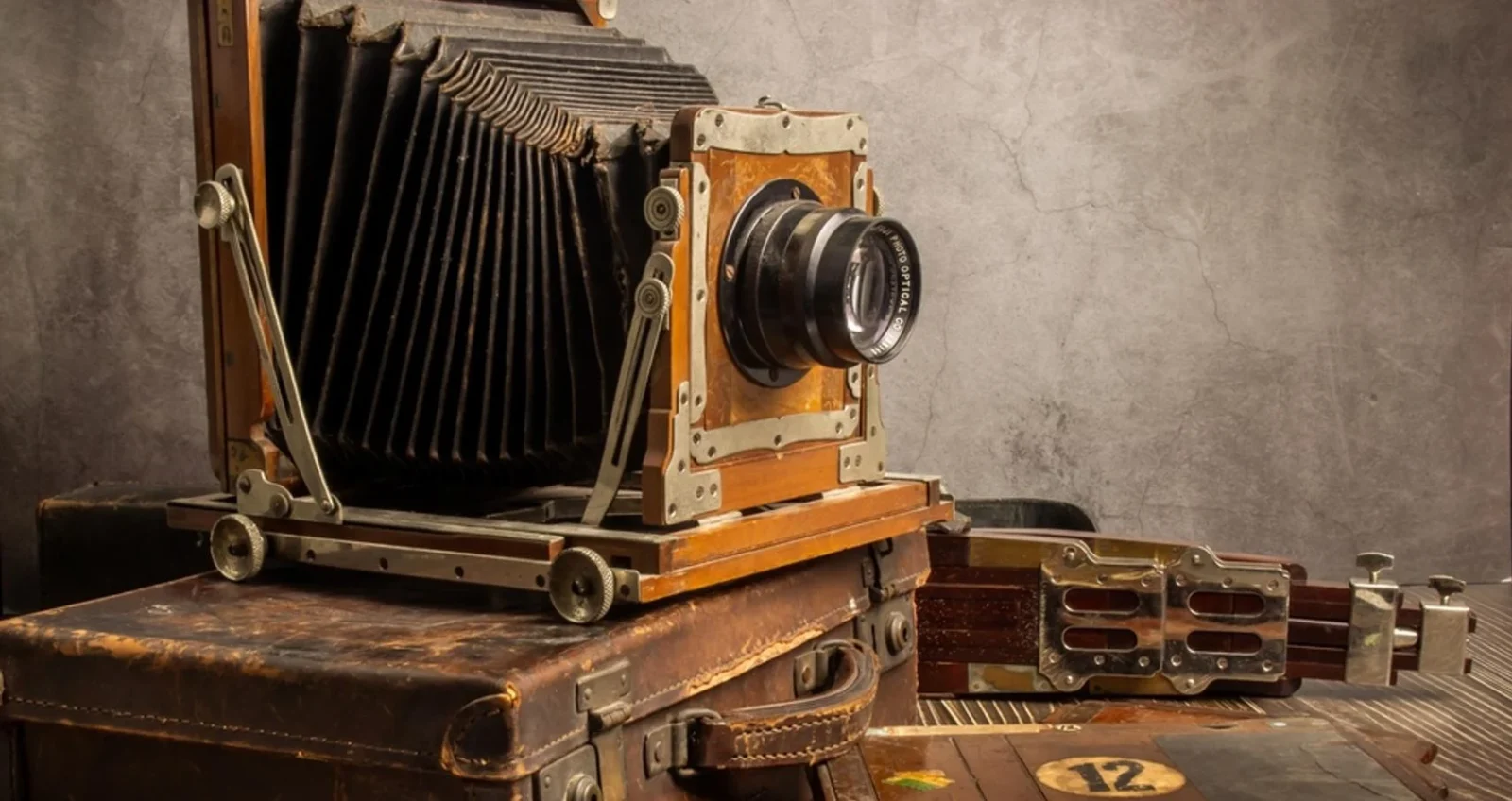Discover The Evolution of Photography & The Science Behind Photography through our Complete Overview.
The Evaluation of Photography has transformed dramatically since its inception in the early 19th century. From rudimentary techniques requiring hours of exposure to the instant gratification of digital images, photography’s evolution mirrors technological advancements and societal changes. This comprehensive exploration delves into the key milestones and innovations that have shaped photography as we know it today.
| Camera Obscura and Early Concepts | |
| Early Beginnings | The Daguerreotype (1839) |
| Talbot’s Calotype (1841) | |
| Wet Plate Collodion (1851) | |
| The Advent of Film | Dry Plate Photography (1871) |
| Roll Film and Kodak (1888) | |
| Color Photography (1907) | |
| 35mm Film and Leica (1925) | |
| The Digital Revolution | The First Digital Cameras (1975) |
| Digital Cameras and the Consumer Market (1990s) | |
| DSLRs and High-Resolution Sensors (2000s) | |
| Mirrorless Cameras (2010s) | |
| Smartphone Photography | |
| Future of Photography | Computational Photography |
| Artificial Intelligence and Machine Learning | |
| Virtual Reality and 360-Degree Photography | |
| Drones and Aerial Photography | |
| Sustainable and Ethical Practices |
Early Beginnings: The Birth of Photography

- Camera Obscura and Early Concepts
The Birth of photography trace back to ancient times with the concept of the camera obscura. This optical device projected an image of its surroundings onto a screen, but it wasn’t capable of capturing a permanent image. Artists in the 16th century used the camera obscura to aid in drawing and painting.
- The Daguerreotype (1839)
Louis Daguerre developed the daguerreotype process, announced in 1839, which is considered the first practical photographic process In The Birth of Photography. It involved exposing a silver-plated copper sheet to iodine vapor, creating a light-sensitive surface. The plate was then exposed to a camera and developed using mercury vapor, producing a detailed, one-of-a-kind image.
- Talbot’s Calotype (1841)
William Henry Fox Talbot introduced the calotype process in 1841. Unlike the daguerreotype, the calotype used paper coated with silver iodide to create a negative image, which could then be used to produce multiple positive prints. This was a significant step towards modern photographic processes.
- Wet Plate Collodion (1851)
Frederick Scott Archer invented the wet plate collodion process in 1851, which combined the best aspects of the daguerreotype and calotype. It involved coating a glass plate with collodion and then sensitizing it with silver nitrate. The process required photographers to prepare, expose, and develop the plates while they were still wet, which made it cumbersome but produced high-quality images.
The Advent of Film: The Rise of Modern Photography

- Dry Plate Photography (1871)
In The Rise of Modern Photography, Richard Leach Maddox introduced the dry plate process in 1871, which used a gelatin emulsion on a glass plate. Unlike the wet plate process, dry plates could be prepared in advance and stored for a period before exposure. This innovation greatly simplified the photographic process and made it more accessible.
- Roll Film and Kodak (1888)
George Eastman revolutionized photography with the introduction of roll film and the Kodak camera in 1888 In The Rise of Modern Photography. The Kodak camera came pre-loaded with a roll of film that could take 100 exposures. After finishing the roll, users would send the camera back to Kodak for development and reloading. Eastman’s slogan, “You press the button, we do the rest,” democratized photography by making it easier and more affordable.
- Color Photography (1907)
Early experiments with color photography date back to the mid-19th century, but practical color photography became possible with the introduction of the Autochrome Lumière process in 1907 by the Lumière brothers. It used dyed grains of starch to create a color filter, producing the first commercially viable color photographs In The Rise of Modern Photography.
- 35mm Film and Leica (1925)
The introduction of the Leica I camera in 1925 popularized 35mm film for still photography. Compact and portable, the Leica camera made photography more convenient and flexible, allowing photographers to capture candid and spontaneous moments.
The Digital Revolution: Photography in the Modern Era
- The First Digital Cameras (1975)

In The Digital Revolution, The first digital camera was developed by Steven Sasson at Eastman Kodak in 1975. It used a CCD image sensor to capture black-and-white images and recorded them on a cassette tape. The prototype was bulky and primitive, but it laid the groundwork for digital photography.
- Digital Cameras and the Consumer Market (1990s)
The 1990s saw the introduction of digital cameras for the consumer market. Early models, like the Apple QuickTake 100 (1994), Kodak DC40 (1995), and Sony Cyber-shot DSC-F1 (1996), offered relatively low resolution and limited storage capacity but paved the way for rapid advancements.
- DSLRs and High-Resolution Sensors (2000s)
The early 2000s marked the rise of digital single-lens reflex (DSLR) Camera. Combining the versatility of SLR cameras with digital technology, DSLRs like the Canon EOS D30 (2000) and Nikon D1 (1999) offered high-resolution sensors and interchangeable lenses, appealing to both professionals and enthusiasts.
- Mirrorless Cameras (2010s)

Mirrorless Camera emerged as a significant innovation in the 2010s in The Digital Revolution. Unlike DSLRs, mirrorless cameras do not have a mirror mechanism, allowing for more compact designs without compromising image quality. Models like the Sony Alpha series and the Fujifilm X series gained popularity for their performance and portability.
- Smartphone Photography

The integration of high-quality cameras into smartphones revolutionized photography once again. Starting with basic cameras in early smartphones, advancements led to models like the iPhone and Google Pixel series, which offer sophisticated imaging capabilities, computational photography, and accessibility. The convenience and connectivity of Smartphone Camera have made them the most widely used cameras today in The Digital Revolution.
Innovations and Trends Shaping the Future of Photography
- Computational Photography
Computational photography uses advanced algorithms to enhance image quality and create effects that would be difficult or impossible with traditional optics alone. Features like HDR, portrait mode, and low-light performance in smartphones are examples of computational photography at work.
- Artificial Intelligence and Machine Learning
AI and machine learning are increasingly being integrated into cameras and editing software. These technologies assist with automatic scene recognition, exposure adjustment, and even subject identification, making photography more intuitive and accessible.
- Virtual Reality and 360-Degree Photography
The rise of virtual reality (VR) has spurred interest in 360-degree photography and videography. Specialized cameras and software allow users to capture immersive experiences, offering new ways to document and explore environments.
- Drones and Aerial Photography

Drones equipped with high-resolution cameras have opened up new possibilities for Drone Photography or Aerial photography and videography. They provide unique perspectives and are used in various fields, from filmmaking to environmental monitoring.
- Sustainable and Ethical Practices
As awareness of environmental and ethical issues grows, the photography industry is moving towards more sustainable practices. This includes the development of eco-friendly materials, reduced waste in film production, and ethical considerations in wildlife and documentary photography.
“Pixel Perfect: Exploring The Science Behind Photography”
Photography is both an art and a science in The Science Behind Photography. While the artistic aspects involve creativity and vision, the scientific foundations underpin the technical capabilities and processes involved in capturing images.
This detailed exploration delves into the scientific principles that make photography possible, from the physics of light to the chemistry of developing photographs and the digital processes that dominate today’s photographic landscape in The Science Behind Photography.
The Physics of Light

- Nature of Light: Light is a form of electromagnetic radiation that behaves both as a wave and a particle (photon). Understanding light’s properties is fundamental to photography, as it affects how images are captured and perceived.
- Light Properties
- Wavelength and Color: Light’s wavelength determines its color. Visible light ranges from about 400 nm (violet) to 700 nm (red).
- Intensity: Light intensity affects exposure. Photographers adjust the amount of light reaching the sensor or film to control the brightness of the image.
- Reflection and Refraction: Light changes direction when it reflects off surfaces or refracts as it passes through different media. Lenses in cameras manipulate these properties to focus light and form clear images.
- Optics and Lenses: Cameras use lenses to focus light onto a photosensitive surface. The design and function of lenses are rooted in the principles of optics.
- Lens Elements: Camera lenses consist of multiple glass elements arranged to correct optical aberrations and improve image quality.
- Focal Length: The distance between the lens and the image sensor when the subject is in focus. It affects the field of view and magnification of the image.
- Aperture: The aperture is the opening in the lens through which light passes. It is adjustable, allowing photographers to control the amount of light entering the camera and the depth of field.
- Depth of Field: The range of distances within which objects appear sharp. It is influenced by the aperture, focal length, and distance to the subject.
The Chemistry of Traditional Photography
- Photographic Film: Traditional photography relies on the chemical reactions of light-sensitive materials to capture images.
- Emulsion: Photographic film is coated with an emulsion containing silver halide crystals suspended in gelatin. These crystals are sensitive to light.
- Exposure: When the film is exposed to light, photons interact with the silver halide crystals, causing a latent image to form. This image is not visible until the film is developed.
- Film Development: The development process converts the latent image into a visible one through a series of chemical reactions.
- Developer: The film is immersed in a developer solution, which reduces the exposed silver halide crystals to metallic silver, forming the visible image.
- Stop Bath: The development process is halted by immersing the film in an acidic stop bath, which neutralizes the developer.
- Fixer: The film is then placed in a fixer solution, which dissolves the unexposed silver halide crystals, making the image permanent and light-resistant.
- Washing and Drying: Finally, the film is washed to remove any remaining chemicals and then dried.
- Color Film: Color film contains multiple layers, each sensitive to different wavelengths of light (red, green, and blue). During development, these layers form dye images in complementary colors (cyan, magenta, and yellow), which combine to create a full-color photograph.
The Digital Revolution in The Science Behind Photography”
- Digital Image Capture: Digital cameras use electronic sensors to capture light and convert it into digital signals.
- Image Sensors: The two main types of image sensors are CCD (Charge-Coupled Device) and CMOS (Complementary Metal-Oxide-Semiconductor). Both types perform the same basic function but differ in how they process and transfer data.
- Photodiodes: Sensors consist of an array of photodiodes, each representing a pixel. When light hits a photodiode, it generates an electrical charge proportional to the light’s intensity.
- Color Filter Array and Interpolation: To capture color, digital sensors use a color filter array, usually the Bayer pattern, which covers each photodiode with a red, green, or blue filter.
- Bayer Pattern: This pattern has twice as many green filters as red or blue, mimicking the human eye’s sensitivity to green light.
- Interpolation: Since each photodiode captures only one color, algorithms interpolate the full-color information for each pixel based on the surrounding pixels.
- Image Processing: After capture, the digital signal undergoes processing to create the final image.
- Analog-to-Digital Conversion: The analog signals from the photodiodes are converted into digital data.
- Image Processing Algorithms: These algorithms include white balance adjustment, noise reduction, sharpening, and color correction.
- File Formats: The processed image can be saved in various file formats, such as JPEG (compressed) or RAW (uncompressed), each with its advantages and uses.
- Storage and Display: Digital images are stored on memory cards and displayed on screens or printed out.
- Memory Cards: These solid-state storage devices vary in capacity and speed, enabling photographers to store thousands of high-resolution images.
- Monitors and Printers: Accurate color reproduction on monitors and printers is crucial for evaluating and displaying digital photographs. Color calibration tools ensure consistency between devices.
Advanced Techniques and Technologies
- High Dynamic Range (HDR): HDR photography involves taking multiple exposures of the same scene at different exposure levels and combining them to capture a greater range of light and shadow details.
- Bracketing: Multiple shots are taken, each with a different exposure setting.
- Merging: Software merges these exposures, preserving details in both highlights and shadows.
- Image Stabilization: Image stabilization technology reduces blur caused by camera movement during exposure.
- Optical Stabilization: Uses gyroscopes to detect movement and adjust the lens or sensor to compensate.
- Digital Stabilization: Software algorithms correct for motion in post-processing.
- Focus Stacking: Focus stacking is used in macro and landscape photography to increase depth of field by combining multiple images taken at different focus distances.
- Capturing: Multiple images are taken, each focused on a different part of the subject.
- Merging: Software merges these images, creating a single photograph with a greater depth of field.
- Computational Photography: Computational photography uses software to enhance image quality and create effects that traditional optics cannot achieve.
- Panorama Stitching: Combining multiple images to create a wide-angle or 360-degree panorama.
- Portrait Mode: Simulating a shallow depth of field using depth data from dual-camera systems or LIDAR sensors.
- Night Mode: Combining multiple exposures to improve low-light performance and reduce noise.
- Artificial Intelligence: AI and machine learning algorithms are increasingly used to automate and enhance various aspects of photography.
- Scene Recognition: AI can identify scenes and subjects, adjusting settings automatically for optimal results.
- Editing Assistance: AI-powered software can suggest edits, enhance images, and even apply artistic styles.
Frequently Asked Questions about The evolution of photography
What are the origins of photography?
The origins of photography can be traced back to the early 19th century with the development of the camera obscura and the first permanent photograph created by Joseph Nicéphore Niépce in 1826.
How has the internet influenced the evolution of photography?
In the evolution of photography, the internet has influenced photography by enabling widespread sharing and distribution of images, creating new platforms for photographers, and fostering a global community of visual storytellers.
What was the daguerreotype process?
The daguerreotype, developed by Louis Daguerre in 1839, was the first publicly announced photographic process. It produced a single image on a silver-coated copper plate.
How did the invention of the Kodak camera impact photography?
The Kodak camera, introduced by George Eastman in 1888, made photography more accessible to the general public by simplifying the process and using roll film instead of glass plates.
What is the significance of Digital Photography?
Digital photography, which emerged in the late 20th century, revolutionized the field by allowing for immediate image review, easy editing, and the ability to share photos instantly across digital platforms.
How have photographic techniques evolved over time?
Photographic techniques have evolved from early processes like the daguerreotype and calotype to modern digital methods, including advancements in camera technology, image processing software, and printing techniques.
How has the purpose of photography changed over time?
While early photography was primarily used for scientific documentation and portraiture, it has expanded to include art, journalism, advertising, and personal expression.
What role has photography played in documenting history?
Photography has played a crucial role in documenting historical events, cultural changes, and everyday life, providing a visual record that complements written history.
What are some major technological advancements in photography?
Major advancements include the development of color photography, autofocus systems, digital sensors, and smartphone cameras.
What is the basic principle behind photography?
The basic principle behind photography is capturing light on a photosensitive surface (film or digital sensor) to create an image. This involves the physics of light and optics.
How do The Digital Revolution sensors capture images?
Digital sensors (CCD or CMOS) capture images by converting light into electrical signals. Each pixel on the sensor measures light intensity and color, which is then processed to form a digital image.
What is the science behind high dynamic range (HDR) photography?
HDR photography combines multiple exposures of the same scene to capture a wider range of brightness levels, resulting in images with more detail in both shadows and highlights.
How do filters impact the science behind photography?
Filters alter the light entering the lens, affecting color balance, contrast, and exposure. Common types include UV filters, polarizers, and neutral density (ND) filters.
What are the principles of depth of field and how is it controlled?
Depth of field is the range of distance within a photo that appears acceptably sharp. It is controlled by the aperture size, focal length, and distance to the subject.
What advancements in technology have improved digital photography?
Technological advancements include higher resolution sensors, better low-light performance, faster autofocus systems, and improved image processing algorithms.
Conclusion
The Evaluation of Photography is a testament to human ingenuity and our desire to capture and preserve moments in time. From the early days of the camera obscura and daguerreotype to the digital revolution and beyond, each innovation has expanded the possibilities of what we can capture and how we share our experiences with the world.
The Science Behind Photography encompasses various disciplines, including physics, chemistry, and digital technology. Each component plays a crucial role in capturing and creating photographs, from the behavior of light and the optics of lenses to the chemical processes of film development and the advanced algorithms in digital imaging.







Leave a Review